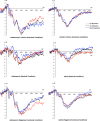Age-Related Differences in the Late Positive Potential during Emotion Regulation between Adolescents and Adults
- PMID: 30952904
- PMCID: PMC6451025
- DOI: 10.1038/s41598-019-42139-4
Age-Related Differences in the Late Positive Potential during Emotion Regulation between Adolescents and Adults
Abstract
The late positive potential (LPP) has been well documented in predicting the effect of emotion regulation in previous developmental literature. However, few studies have examined age-related changes in emotion regulation from adolescence to adulthood using this biomarker. To test this, Reactivity and Regulation-Image Task was used to test 18 young adolescents and 22 adults to examine the modulation of LPP during emotion regulation. Results revealed that (a) on the behavioral level, adults reported higher intensity of emotional experience than adolescents when they were asked to use up-regulation. Down-regulation showed no age effect for self-reported rating; (b) adolescents showed higher amplitudes of LPP than adults when using different regulatory strategies in all windows; (c) In late time window, regulation effect was larger when using up-regulation strategy than down-regulation strategy for adolescents, while the difference between the two strategies was negligible for adults. (d) In early time window, reactivity effect was larger in negative conditions than in positive conditions for adolescents, while the difference between the two conditions was again negligible for adults. Differences in the amplitudes and time courses of LPP during emotion regulation between adolescents and adults suggested that age-related changes in emotion regulation may occur during adolescence.
Conflict of interest statement
The authors declare no competing interests.
Figures






Similar articles
-
Emotion regulation in adolescents: An ERP study.Biol Psychol. 2017 Oct;129:52-61. doi: 10.1016/j.biopsycho.2017.08.001. Epub 2017 Aug 10. Biol Psychol. 2017. PMID: 28803782
-
Neural underpinnings of the relationships between sensation seeking and emotion regulation in adolescents.Int J Psychol. 2020 Oct;55(5):851-860. doi: 10.1002/ijop.12649. Epub 2019 Dec 26. Int J Psychol. 2020. PMID: 31879953
-
Maternal emotion regulation abilities affect adolescent depressive symptoms by mediating their emotion regulation ability: An ERP study.Asian J Psychiatr. 2024 Dec;102:104190. doi: 10.1016/j.ajp.2024.104190. Epub 2024 Aug 30. Asian J Psychiatr. 2024. PMID: 39288639
-
Event-related potentials, emotion, and emotion regulation: an integrative review.Dev Neuropsychol. 2010;35(2):129-55. doi: 10.1080/87565640903526504. Dev Neuropsychol. 2010. PMID: 20390599 Review.
-
The role of emotion regulation in socially anxious children and adolescents: a systematic review.Eur Child Adolesc Psychiatry. 2020 Nov;29(11):1479-1501. doi: 10.1007/s00787-019-01359-9. Epub 2019 Jun 14. Eur Child Adolesc Psychiatry. 2020. PMID: 31201527
Cited by
-
Cognitive reappraisal improves the social decision-making performance of suicide attempters.Fundam Res. 2024 Jul 2;5(1):115-123. doi: 10.1016/j.fmre.2024.06.008. eCollection 2025 Jan. Fundam Res. 2024. PMID: 40166125 Free PMC article.
-
Teachers' interpersonal styles and fear of failure from the perspective of physical education students.PLoS One. 2020 Jun 24;15(6):e0235011. doi: 10.1371/journal.pone.0235011. eCollection 2020. PLoS One. 2020. PMID: 32579576 Free PMC article.
-
The Immediate and Lasting Effect of Emotion Regulation in Adolescents: An ERP Study.Int J Environ Res Public Health. 2021 Sep 29;18(19):10242. doi: 10.3390/ijerph181910242. Int J Environ Res Public Health. 2021. PMID: 34639542 Free PMC article.
-
Emotional regulation and self-perceived quality of life in high-performance mountain sports athletes.Front Psychol. 2024 Apr 16;15:1370124. doi: 10.3389/fpsyg.2024.1370124. eCollection 2024. Front Psychol. 2024. PMID: 38689724 Free PMC article.
-
ViE-Take: A Vision-Driven Multi-Modal Dataset for Exploring the Emotional Landscape in Takeover Safety of Autonomous Driving.Research (Wash D C). 2025 Mar 14;8:0603. doi: 10.34133/research.0603. eCollection 2025. Research (Wash D C). 2025. PMID: 40093973 Free PMC article.
References
Publication types
MeSH terms
LinkOut - more resources
Full Text Sources

